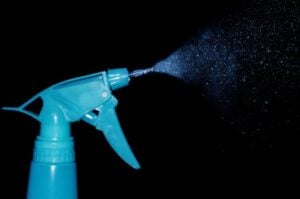As with any sticker or wallpaper removal, there is always the possibility of sticky residue being left behind. Don’t let this chance occurrence deter you from decorating your home or office with a fresh new peel and stick wall mural. Removing sticker residue from your walls is a simple process with the right tools and preparation. If you are looking for ways on how to remove sticker residue from walls, below are some suggestions and tips to get you on your way. If you need some help removing your mural from the wall first, check out this article here!
1. Protect your room and furniture.
Prepare the room like you would for painting. Move furniture away from walls to the center of the room. Cover both your furniture and flooring with drop cloths or tarps to protect them from any splattering of cleaning products, etc.
2. Prepare a cleaning solution.
There are many products you can purchase to clean the residue, but why use an expensive and possibly toxic method when there are so many tried and true methods you can use right in your own cabinet? Here are a few alternates that will do the job inexpensively, safely, and well—removing that pesky residue without damaging your paint or wall underneath!

-
Hot water and dishwashing liquid.
- Mix some hot water with a few drops of dishwashing liquid. Use a spray bottle or sponge and gently apply to a section of the wall. You should see the sticker residue wipe away as it softens. Or if using a spray bottle, carefully scrape with a putty knife or other flat object to remove the softened glue. (For a bit of extra oomph, try adding a tablespoon of baking soda to your mixture.)
-
Vinegar and warm water
- Another effective, albeit fragrant way to remove sticker residue, is by mixing a few ounces of cider or white vinegar into a bucket of warm water. If using a spray bottle, try a 50/50 mix of water and vinegar, or if using a sponge, 1 part vinegar to 6 parts warm water should do the trick. No matter which method you use to apply the vinegar mixture, let sit for a few minutes before removing.
-
Fabric Softener
- For a more pleasant smelling solution, try mixing 1 part liquid fabric softener with 2 parts water. This method also can be applied with a spray bottle or sponge, but just make certain to work in smaller section as the fabric softener could stain the rest of the wall, leaving streaks.
-
Clothes steamer
- If you happen to have a clothing steamer on hand, this handy little gadget can also serve a dual purpose. Simply place the steamer near the sticker residue and let the steam soften the glue. Once softened, the sticky residue should just wipe away.
3. Rinse cleaning solution.
No matter which cleaning solution you’ve chosen, once applied make sure you have a bucket of clean, warm water to wash the solution and any sticker residue it removes. Using a sponge, wipe away solution and residue, frequently rinsing to keep from leaving any smears behind. You may have to repeat the cleaning solution process to remove any leftover residue.
4. Remove any residue.
Take a clean, dry cloth and wipe any residue, cleaning solution, or rinse water away. If you still have a few stubborn spots, try using a wallpaper scraper or plastic drywall knife and scrape away. If necessary, use fine grit sandpaper to remove any rough patches.
5. Drying time.
Make sure you allow your walls to fully dry before applying a new wall mural. This allows for proper adhesion of your new décor so that it will last for years to come.
Tips
- Keep the water hot. Make sure you mix your cleaning solutions in smaller batches in order to keep the water as hot as possible for most effective removal.
- Make sure to cover any electrical outlets. To prevent any possible shock or injury using a liquid solution, make sure to cover the outlets or turn off the power at the breaker.
- Work in small sections that can easily be worked in a few minutes. This keeps the solution from drying out before you begin working on it.
- Do not oversaturate your walls. If you apply too much cleaning solution or rinse water, you could damage your drywall effectively weakening the structure.



